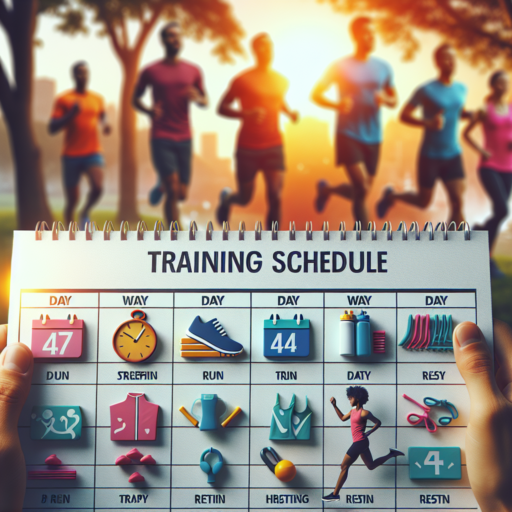Introduction to 14-Week Beginner Half Marathon Training Plan
Embarking on a 14-week beginner half marathon training plan can be an exhilarating yet challenging journey. Tailored for individuals who are new to the half marathon scene or looking to take their casual running to a competitive level, this guide is structured to gradually increase your stamina, endurance, and confidence. Whether you’re transitioning from 5K races or simply wish to accomplish a significant running milestone, this plan serves as your step-by-step guide to crossing the finish line with pride.
Understanding the essence of the 14-week timeframe is crucial. It provides ample opportunity for beginners to adapt, both physically and mentally, to the demands of longer distances. Unlike shorter, more intense training schedules, this plan focuses on progressively building your running base through a balanced mix of running, rest, and cross-training days. The primary aim is not just to enhance your running capacity, but also to minimize the risk of injury, ensuring you arrive at the start line healthy and eager.
The structure of the 14-week plan is methodically designed to suit individuals with varying levels of fitness. Initially, the focus is on establishing consistent running habits, gradually increasing in volume and intensity. Key components of the training include weekly long runs, which are critical for endurance building, speed work to improve your pace, and strength training sessions to build muscle resilience and support overall body balance. Every training week will contribute to your ultimate goal of completing a half marathon, making each run an integral step on your journey.
Week-by-Week Breakdown of Your Half Marathon Training Schedule
Embarking on a half marathon journey entails meticulous preparation, a robust training schedule, and an unwavering commitment. Understanding the structure of a comprehensive half marathon training program can help you optimize your performance come race day. This week-by-week breakdown aims to provide clarity, focus, and progress tracking to ensure you are race-ready.
Initial Weeks: Building a Base
In the nascent weeks of your half marathon training, the focus should squarely be on building a solid aerobic base. Gradually increasing your weekly mileage at a comfortable pace is crucial. These weeks involve consistent, moderate-paced runs, complemented by at least one day of cross-training to enhance your overall fitness without overstraining your running muscles. Remember, the goal during this phase is to increase endurance and establish a consistent running habit.
Middle Weeks: Introducing Variety and Building Strength
As your training progresses, the middle weeks are all about introducing variety into your runs to build strength and improve your running efficiency. This phase will feature your first long-distance runs, which are pivotal for mental and physical adaptation to prolonged periods of running. Including speed work, such as intervals and tempo runs, during these weeks helps in improving your cardiovascular capacity. Strength training sessions are also essential to bolster your running economy and to prevent injuries.
Final Weeks: Tapering and Race Preparation
The concluding weeks of your half marathon training are dedicated to tapering, allowing your body to recover and attain peak performance on race day. Reducing your mileage gradually will help prevent fatigue and reduce the risk of injury. This phase is not only about physical preparedness but also mental preparation. It’s imperative to adjust your diet, ensure proper hydration, and visualize your race day strategy. Fine-tuning your pacing and finalizing your race day kit are also crucial steps during these final weeks.
Essential Gear for Your 14-Week Half Marathon Prep
Preparing for a half marathon is an exciting journey, and having the right gear can make a significant difference in your training and performance. Over a 14-week prep, you will need equipment that supports your body, improves your running experience, and prevents injuries. Selecting the optimal gear is crucial to tackling the miles ahead with confidence.
Footwear: The Foundation of Your Running Gear
At the core of essential gear is a pair of high-quality running shoes. Selecting shoes designed for your gait and foot structure is imperative. During your 14-week preparation, consider visiting a specialty running store for a professional fitting. A shoe with the correct support and cushioning can prevent blisters, shin splints, and other running-related injuries. Additionally, it’s wise to invest in a second pair mid-preparation to ensure your footwear is not overly worn by race day.
Technical Apparel: Comfort Meets Functionality
Running apparel is not merely about style; it’s about performance and comfort. Opt for moisture-wicking fabric that keeps you dry, thermal layers for colder runs, and breathable materials for those long, sunny days. Essential pieces include a supportive sports bra for women, compression shorts or leggings to reduce muscle fatigue, and lightweight jackets for unpredictable weather. Remember, the right clothing can substantially affect your motivation and performance throughout the 14 weeks.
Every runner’s half marathon journey is unique, yet the importance of selecting the right gear is universal. From one’s choice in footwear to the technicality of their apparel, the equipment plays a supportive role in crossing the finish line. Investing in quality gear at the start of your prep can lead to a more enjoyable and successful training period, setting you up for a memorable race day.
No se han encontrado productos.
Nutrition and Hydration Tips for Half Marathon Success
Preparing for a half marathon requires not only rigorous training but also a meticulous focus on nutrition and hydration. These two components play a fundamental role in your stamina, energy levels, and overall performance. Understanding the right balance can be the key to crossing the finish line with your best time yet.
Strategizing Your Nutritional Intake
When it comes to fueling your body for a half marathon, carbohydrates are paramount. They are your body’s primary source of energy for endurance activities. Starting a carbohydrate «load» a few days before the event can help to increase your muscle glycogen stores. It’s essential to focus on complex carbohydrates such as whole grains, fruits, and vegetables, interspersed with lean proteins to aid in muscle recovery and repair. Remember, the goal is to enhance performance and energy, not to feel weighed down.
Mastering Hydration Before and During the Run
Hydration is another critical factor in half marathon success. Begin hydrating several days before the event to ensure that your body is properly prepared. On the day of the marathon, drink a large glass of water a couple of hours before the start to allow time for absorption and any necessary restroom visits. During the race, take advantage of water stations even if you don’t feel thirsty to prevent dehydration. Small sips of water or isotonic sports drinks can help you maintain electrolyte levels without causing discomfort or waterlogging.
Remember, nutrition and hydration strategies should be personalized and tested during your training sessions to avoid any surprises on race day. Taking these steps to ensure your body is properly fueled and hydrated can significantly impact your half marathon experience and success.
Injury Prevention and Recovery Strategies During Training
Preparing your body for the intensity of training sessions not only enhances performance but significantly reduces the risk of injuries. Integrating injury prevention and recovery strategies into your routine is essential. This not only ensures your body’s resilience but also maximizes the benefits of your workout sessions. Focusing on proper techniques, incorporating rest days, and adopting habits that promote recovery can make a substantial difference in your training outcomes.
Key Techniques for Injury Prevention
- Dynamic Warm-Ups: Beginning your session with dynamic stretches increases blood flow and prepares your muscles and joints for the activity ahead.
- Proper Form: Ensuring you’re performing exercises correctly is crucial. Incorrect form can lead to strain and injury, negating the benefits of your workout.
- Equipment Use: Using appropriate gear, such as supportive shoes, can provide the necessary support to prevent injuries related to impact and strain.
Effective Recovery Methods
- Cooldown: Ending sessions with a cooldown phase helps in gradually reducing the heart rate and begins the recovery process immediately.
- Hydration and Nutrition: Replenishing lost fluids and nutrients aids in muscle repair and recovery, preparing your body for the next training session.
- Rest and Sleep: Giving your body adequate rest is equally important as the training itself. Sleep promotes healing and prepares the body for upcoming challenges.
Incorporating these focused injury prevention and recovery strategies will not only safeguard against potential setbacks but also enrich your training experience. Emphasizing these aspects can lead to healthier habits, ultimately contributing to a more sustainable and effective training journey.
Understanding Your Body: Pace and Effort in Training
When it comes to optimizing training, understanding the relationship between pace and effort is crucial. Pace, often measured in terms of speed or duration, and effort, commonly gauged by perceived exertion or heart rate, are both key factors in designing an effective training regimen. Recognizing how these components influence your body can help in fine-tuning workouts to match your fitness goals more precisely.
The interplay between pace and effort is not always linear. For example, a slower pace doesn’t automatically mean less effort – think of a long, grueling run at a steady pace. Conversely, short bursts of high-speed sprints demand immense effort in a brief timeframe. Each type of training impacts your body differently, influencing everything from cardiovascular health to muscle strength. It’s essential to balance these aspects to ensure a comprehensive training approach that boosts overall performance and minimizes the risk of injury.
Listening to your body is paramount in understanding the balance between pace and effort. Signs of overexertion, such as excessive fatigue, persistent soreness, or a decline in performance, may indicate a need to adjust your training regimen. Equally, feeling under-challenged can signify it’s time to increase your pace or effort. Regularly assessing your training outcomes and how your body responds can guide adjustments that lead to more effective workouts.
3 Core Workouts to Complement Your Marathon Training
Running a marathon requires more than just endurance and long-distance running; it demands a strong core to maintain form, posture, and efficiency throughout the race. Integrating core workouts into your marathon training plan can improve your running economy and reduce your risk of injury. Here, we’ll explore three essential core workouts that are specifically designed to support marathon runners.
Planks for Core Stability
Planks are a versatile core exercise that targets not only the abdominal muscles but also the shoulders, chest, and back. For marathon runners, the plank helps in building a solid foundation by enhancing core strength and stability. Incorporating variations such as side planks can also engage and strengthen the obliques, which are crucial for maintaining balance and stability during long runs.
Bridge Exercises for Lower Back and Glute Strengthening
Bridge exercises are pivotal for improving core strength, focusing on the lower back, glutes, and hamstrings. Strengthening these areas is essential for marathon runners to boost their propulsion and protect the spine, especially during the final miles of a race. Regularly performing bridges can lead to better posture and decreased likelihood of running-related injuries.
Leg Raises to Enhance Core Endurance
Leg raises are another effective workout for targeting the lower abdominal muscles, a vital area for runners. Enhanced strength in the lower abdominals can lead to improved stability and posture, which are critical for efficient running mechanics. Incorporating leg raises into your core workout routine can help build endurance in the core muscles, allowing them to support longer distances without fatigue.
Mental Preparation: Getting Ready for Race Day
Mental preparation is as crucial as physical training when gearing up for race day. It’s the foundation that can set athletes apart, determining not just performance but also the ability to enjoy and overcome the challenges of the competition. Understanding the psychological hurdles and employing strategies to conquer them are essential steps in your pre-race routine.
Visualization techniques stand out as powerful tools in mental preparation. By envisioning the race course, the crowd, and even potential obstacles, athletes can build confidence and reduce pre-race anxiety. It’s not just about positive outcomes; visualizing how to handle difficult situations can also prepare the mind for any eventualities. Embracing a mindset of resilience and adaptability becomes easier with regular practice of these techniques.
Setting realistic goals is another critical aspect of mental readiness. Goals should challenge the athlete but remain achievable, providing a clear focus that can guide training and strategy. It’s essential to balance ambition with pragmatism to avoid unnecessary pressure that can derail mental preparedness. Reflecting on past performances can aid in setting these goals, as long as the athlete maintains a constructive and forward-looking perspective.
Lastly, developing a pre-race routine that includes mental rehearsal, relaxation techniques, and a focus on positive self-talk can significantly impact an athlete’s mindset on race day. Whether it’s through listening to motivational music, deep breathing exercises, or repeating affirmations, finding what works best for you is key. Integrating these habits into your daily training will ensure they become second nature, allowing you to approach race day with confidence and a calm mind.
Tapering Before the Race: How to Reduce Training Correctly
Tapering is a crucial phase for athletes, especially runners, as they approach race day. It involves the strategic reduction of training volume and intensity to allow the body to rest, recover, and prepare for optimal performance. Understanding the fundamentals of tapering is essential for maximizing your race potential and avoiding common pitfalls that can lead to underperformance or injury.
Identifying the Optimal Tapering Duration
One key element in tapering correctly is identifying the optimal duration. Typically, tapering periods can range from one to three weeks, depending on the race distance and your training regimen. For longer races, such as marathons, a longer taper period allows for full recovery from the cumulative fatigue of training. Conversely, shorter races, like 5Ks or 10Ks, may require a shorter taper to maintain the sharpness of your running form and speed.
Adjusting Training Volume and Intensity
Adjusting training volume and intensity is at the heart of effective tapering. A common strategy involves gradually reducing the training volume while maintaining or slightly reducing intensity. This approach helps preserve fitness levels while minimizing fatigue. For instance, you might reduce your weekly mileage by 20-30% each week during the taper period while including a few short, race-pace efforts to stay sharp.
Furthermore, it’s crucial to listen to your body during this phase and be willing to adjust your tapering strategy as needed. Factors such as stress, sleep quality, and overall health can affect how your body responds to tapering, making flexibility a key component of a successful taper.
Final Tips and Motivation for Your First Half Marathon
Embarking on the journey to complete your first half-marathon is an adventurous and exciting process. There’s much to prepare for and numerous considerations to be mindful of. To ensure your training and race day go as smoothly as possible, here are final tips and motivation that will guide you towards the finish line.
Firstly, it’s crucial to trust in your training. You’ve likely followed a structured training program leading up to the race. Remember, this program was designed to equip you with the stamina and strength needed for the half marathon. Doubts might arise, but it’s essential to stay confident in the work you’ve put in. Remember, every long run, interval training, and rest day was a step closer to this moment. Trust that your body knows what to do.
Adapting Your Strategy
On race day, it’s wise to have a strategy but be flexible enough to adapt. The dynamics of a half-marathon can be unpredictable with varying weather conditions, crowd support, and how you feel on the day. You might find yourself adjusting your pace, hydration strategy, or nutrition plan. It’s okay to deviate from the original plan if it means listening to your body and ensuring a successful finish. Being mentally prepared to make these adjustments is half the battle won.
In conclusion, running your first half marathon is a remarkable achievement of physical and mental strength. Hold onto the excitement and use it as fuel. When the distance feels daunting, remember why you started. Celebrate every milestone, no matter how small, and know that the race is as much about the journey as it is about the finish line. With these final tips and a steady dose of motivation, you’re ready to take on the challenge head-on.




